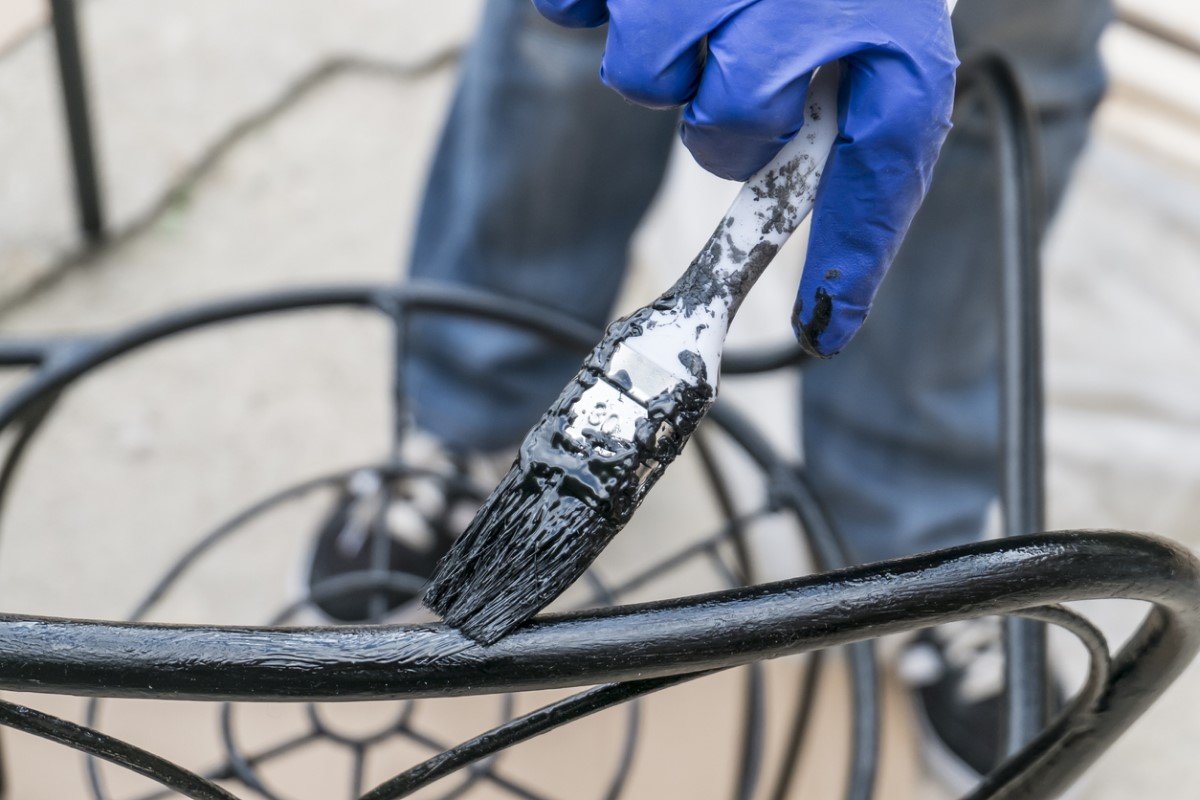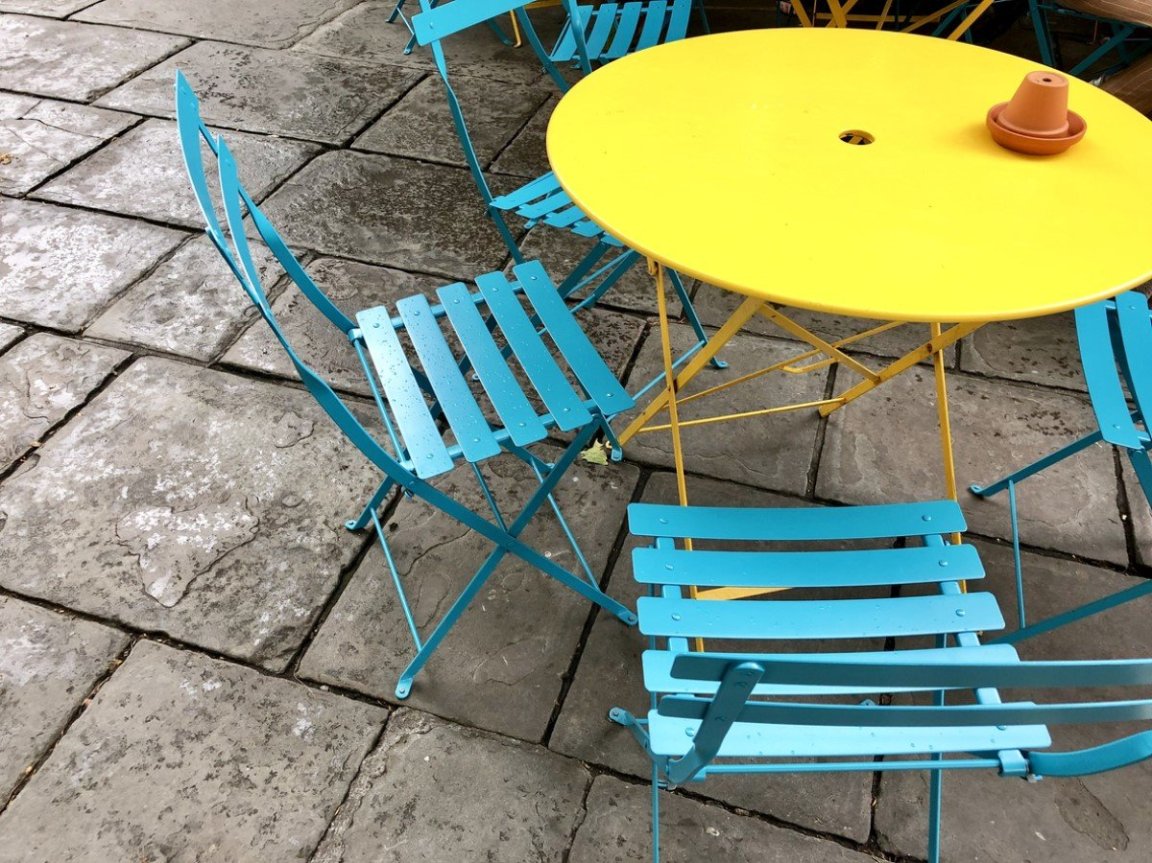We may earn revenue from the products available on this page and participate in affiliate programs. Learn More ›
Q: My metal patio chairs are starting to chip and rust. Will I get good results if I touch them up with exterior latex paint I have left over from another project? If not, what’s the best paint for metal?
A: Due to its slick, smooth surface, metal can be challenging to paint—and that can of paint you have languishing in the garage probably won’t cut it. Before you open any paint, it’s important to know how to prep metal for optimal paint adhesion: First, clean it with soap and water, remove light rust with a wire brush, sand it with fine-grain sandpaper, and then (in most cases) prime it. After you take these preparatory steps, know that the only way your project will turn out well is if you use a paint that is specifically formulated for metal, or a multi-surface paint that is labeled for use on metal.
So all you need is paint that works on metal, right? Er, sorta. Here’s where it gets complicated: There are both oil- and water-based paints for use on metal, and formulations you can either spray on or brush on. There are also specialized formulas that can handle extreme heat or fend off rust, which you might consider if you’re painting things like patio grills or fire pits. Ahead, learn how to determine the best paint for metal projects of all kinds, indoors and out.

Oil-based paints are the most durable.
With prices averaging $40 to $70 per gallon, oil-based paint is generally more expensive than water-based paint. It is formulated with pigments, alkyds (synthetic resins) or plant-based oil, and solvent (this is what causes the smelly fumes during application), which cure to a rigid coat that repels water and stains, and resists dents and scuffs.
Opt for oil-based paint if you’re painting heavy-duty metal surfaces such as:
- fences
- patio furniture
- backyard grills
- heavily used indoor items, like cabinets and window frames
The downsides of oil-based paint are that it is vulnerable to cracking or chipping, and tends to fade over time. For this reason, consider a product with built-in fade protection, such as Rust-Oleum Hammered rust preventive paint.
You’ll achieve a more uniform finish if you first apply an oil-based primer, like Rust-Oleum Clean Metal Primer. You can apply oil paint directly to metal because it doesn’t contain water, and therefore won’t rust it. Though skipping primer may save you some time on your paint job, you’ll still be waiting a while for the oil-based paint to dry to the touch (usually 6 to 8 hours).
RELATED: How To: Paint Metal
Water-based paint for metal dries faster and emits fewer fumes.
Water-based acrylic paint is cheaper ($20 to $50 per gallon) and dries faster than oil paint. It’s made of pigments, acrylic resins, and water. It dries to the touch in under an hour into a flexible coat resistant to cracking, chipping, and fading. Because it’s more vulnerable to dents, stains, and scuffs than oil paint, it’s best used on indoor metal surfaces that get light to moderate use, such as:
- wall sconces
- bed frames
- guest room nightstands
The typical acrylic paint also contains less organic material than oil paint so it’s less likely to form mildew and mold, making it a better option for metal surfaces in moisture-prone areas like kitchens and baths. Remember that exposing metal to water-based paint can rust it, so you’ll always want to apply an oil-based primer before painting with acrylic paint.
Spray paint offers better, more uniform coverage of irregular surfaces.
Both oil- and water-based metal paints come in quart- or gallon-sized cans, for use with brushes or rollers, or aerosol cans, for spray application. Large cans are the most cost-effective options when painting large, linear metal objects such as fences and backsplashes, but spray paints such as Rust-oleum Hammered are more convenient when you want to cover smaller surfaces with irregular contours. Spray painting metal is the way to go on projects such as:
- curved patio chair legs
- mesh or patterned chair backs
- chains
- bed frame posts
Spray paint can cover these metal surfaces more smoothly and with fewer applications than with a brush. By spray painting metal, you’ll avoid brush marks and drips.
RELATED: We Tested the Best Spray Paints for Metal and This Was The Winner

Choose rust-resistant paint on moisture-prone surfaces.
With prolonged exposure to air and moisture, rust can form on steel or any metal made of iron or iron alloys. If you plan to paint metal outdoor furniture or décor, or interior features like backsplashes that regularly come into contact with water or humidity, look for paint designed to resist rust (e.g., Behr’s Direct-to-Metal paints, or Rust-Oleum-branded products) to preserve the look and integrity of the metal.
Use high-heat paint on heat-generating surfaces.
Are you painting a radiator, outdoor grill, fire pit surround, or another heat-generating appliance? Regular oil- or water-based paint can blister and peel when exposed to the high temperatures generated by these appliances during operation. To preserve your paint job, choose a high-heat metal paint formulated with heat-resistant resins to withstand high temperatures, such as Rust-Oleum High Heat Spray Paint.

